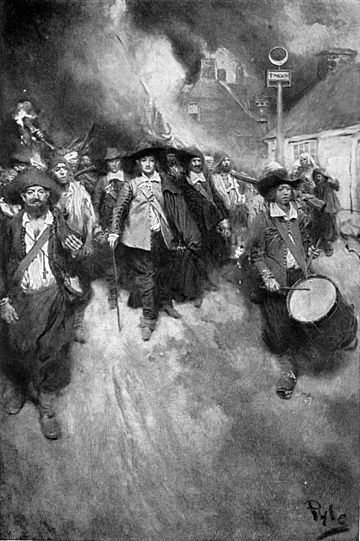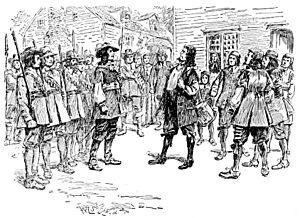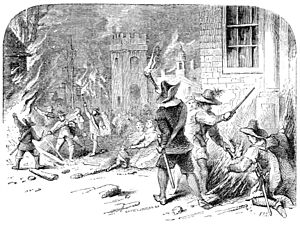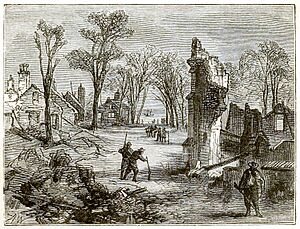Bacon's Rebellion facts for kids
Quick facts for kids Bacon's Rebellion |
|||
|---|---|---|---|

The Burning of Jamestown by Howard Pyle
|
|||
| Date | 1676–1677 | ||
| Location | |||
| Goals | Change in Virginia's policy toward Native Americans | ||
| Methods | Demonstrations, armed attacks | ||
| Resulted in |
|
||
| Parties to the civil conflict | |||
|
|||
| Lead figures | |||
|
|||
| Number | |||
|
|||
| Casualties | |||
|
|||
| Hundreds of Occaneechi and Pamunkey people killed by rebels Over 100 settlers killed in Native American raids |
|||
Bacon's Rebellion was an armed uprising that happened in the Colony of Virginia from 1676 to 1677. It was led by a colonist named Nathaniel Bacon. He and his followers fought against the colonial governor, William Berkeley.
The main conflict started because Bacon wanted to attack Native American tribes, but Governor Berkeley refused to allow it. Thousands of Virginians, including poor farmers, indentured servants, and enslaved Africans, joined Bacon. They chased Governor Berkeley out of the capital, Jamestown, and burned it to the ground.
The rebellion was eventually stopped by government forces. Even though the rebellion failed, it led to Governor Berkeley being sent back to England. Bacon's Rebellion was the first major rebellion in the American colonies where frontier settlers took part. It also worried the wealthy ruling class because it showed that poor white and black people could unite against them. This fear led to new, stricter laws about slavery.
Contents
Why Did the Rebellion Happen?
In the 1670s, many colonists in Virginia were unhappy. There were several reasons for this.
Fights Over Land
Colonists wanted more land to grow tobacco, which was the main way to make money. This land was often already home to Native American tribes. As settlers pushed further west, it led to more fighting with tribes who were defending their homes.
Governor Berkeley tried to keep peace with some of the tribes, partly because he was involved in the valuable fur trade with them. But many settlers on the frontier felt the governor was not protecting them from attacks. They wanted to remove all Native Americans from the area.
Money Problems
The price of tobacco had dropped, which meant small farmers were earning very little money. At the same time, the governor and the English government placed high taxes on them. Many colonists felt that Governor Berkeley and his wealthy friends were getting richer while they were struggling to survive.
Unfair Government
Governor Berkeley had been in power for a long time. Many people believed he only gave powerful jobs to his friends and passed laws that helped the rich. In 1670, a new law took away the right to vote from men who did not own land. This made many poor colonists feel like they had no say in their own government.
The Rebellion Begins
Clashes with Native Americans
In 1675, a dispute between settlers and the Doeg tribe led to violence. In response, colonial militias attacked not only the Doeg but also the friendly Susquehannock tribe by mistake. This led to a series of raids by Native American warriors on frontier farms. Settlers were angry and scared, and they demanded that the governor take action.
Governor Berkeley's plan was to build a series of forts along the frontier. However, settlers thought this was too defensive and expensive. They wanted to attack the Native American tribes directly.
Bacon Becomes a Leader
Nathaniel Bacon was a wealthy landowner who had recently arrived in Virginia. He was also a cousin of Governor Berkeley's wife. Despite his connections, Bacon sympathized with the frontier settlers.
When Governor Berkeley refused to let Bacon lead a volunteer army against the Native Americans, Bacon decided to act on his own. He led a group of armed men and attacked some peaceful Native American tribes, like the Occaneechi. Governor Berkeley declared Bacon a rebel and a traitor.
Key Events of the Rebellion
March on Jamestown
In June 1676, Bacon was elected to the House of Burgesses, Virginia's assembly. He traveled to Jamestown with 40 armed men but was captured. Governor Berkeley pardoned him, but Bacon soon escaped.
A short time later, Bacon returned to Jamestown with 500 followers and demanded to be made a general of the militia. In a famous moment, Governor Berkeley stood before Bacon, opened his shirt, and dared Bacon to shoot him. Bacon did not shoot him. Instead, he had his men aim their guns at the House of Burgesses. The assembly quickly gave in and made Bacon a general.
The Declaration of the People
In July 1676, Bacon issued the "Declaration of the People". This document listed many complaints against Governor Berkeley. It accused him of:
- Charging unfair taxes.
- Giving powerful jobs to his friends.
- Controlling the fur trade for his own profit.
- Not protecting the colonists from Native American attacks.
Bacon's army forced many important Virginians to swear an oath of loyalty to him. Meanwhile, Governor Berkeley fled to Virginia's Eastern Shore.
The Burning of Jamestown
Governor Berkeley gathered his own forces and retook Jamestown in September. Bacon's army marched back to the capital and laid siege to it.
On September 19, 1676, Bacon and his men decided to burn Jamestown to the ground. They did this to prevent Berkeley from using it as a base. The fire destroyed the church, the statehouse, and many homes. Jamestown would never fully recover as the capital of Virginia.
The End of the Rebellion
Bacon's Death
After burning Jamestown, Bacon continued to fight against Berkeley's supporters. However, just a month later, on October 26, 1676, Nathaniel Bacon died suddenly from dysentery, a severe illness. He was only 29 years old. Without its charismatic leader, the rebellion quickly began to fall apart. A man named John Ingram took over, but he could not keep the rebels united.
The Rebellion is Stopped
Governor Berkeley, with the help of armed English ships, began to defeat the scattered groups of rebels. English soldiers also arrived from England to help restore order. By early 1677, the rebellion was over.
Berkeley was harsh in his punishment of the rebels. He captured and executed 25 of the rebellion's main leaders. When King Charles II heard about this, he was not pleased with Berkeley's actions.
What Happened After the Rebellion?
King Charles II removed William Berkeley from his post as governor and ordered him to return to England. Berkeley died in July 1677, not long after he arrived.
A new governor, Herbert Jeffreys, was sent to Virginia. He worked to restore peace. In 1677, he signed the Treaty of 1677 with several Native American tribes. This treaty made the tribes subjects of the King of England and set aside land for them.
The rebellion had a major impact on Virginia's future. The wealthy ruling class was terrified that poor white and black people had joined together to fight them. To prevent this from happening again, they passed stricter laws to separate the races. These laws, known as the Virginia Slave Codes of 1705, hardened the system of slavery and took away rights from black people, both free and enslaved. The government also became more aggressive in taking land from Native Americans to give to poor white settlers, hoping to keep them loyal.
Legacy
For many years, some people saw Nathaniel Bacon as a hero who fought against a corrupt governor. They viewed his rebellion as an early step toward the American Revolution.
Today, most historians see the event as more complicated. They view it as a power struggle between two selfish leaders, Bacon and Berkeley. They also point out that one of Bacon's main goals was to attack and remove Native Americans.
The most important legacy of Bacon's Rebellion was how it changed society in Virginia. It led to a system where race, not class, became the main dividing line between people. This had long-lasting effects on the history of slavery and race relations in America.
See also
- Cockacoeske, Pamunkey chief
- Queen Ann (Pamunkey chief)
- Bacon's Castle
- Culpeper's Rebellion




